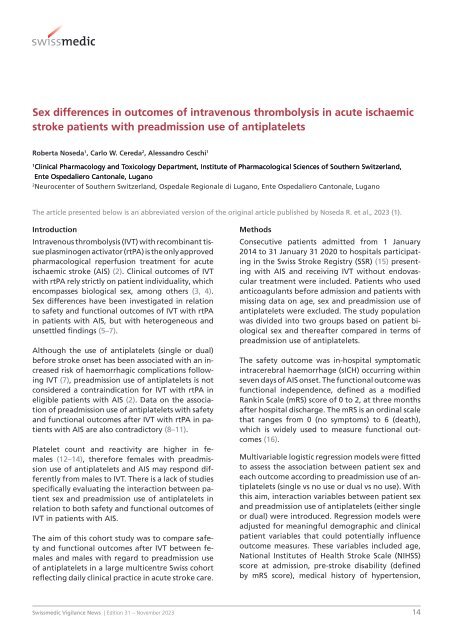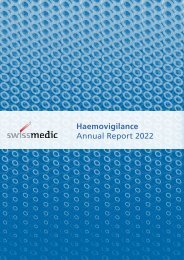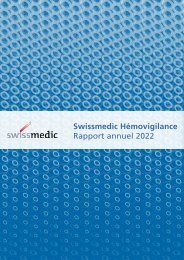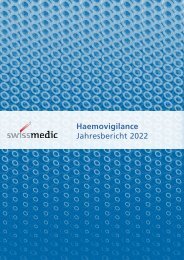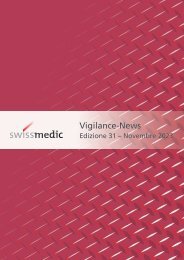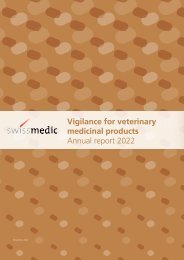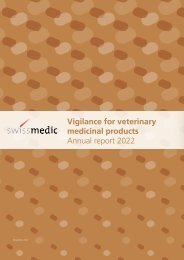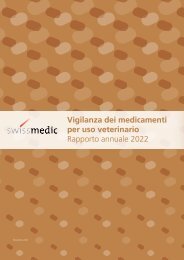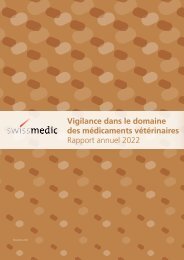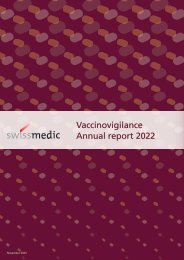Swissmedic Vigilance News
Edition 31 – November 2023
Edition 31 – November 2023
You also want an ePaper? Increase the reach of your titles
YUMPU automatically turns print PDFs into web optimized ePapers that Google loves.
Sex differences in outcomes of intravenous thrombolysis in acute ischaemic<br />
stroke patients with preadmission use of antiplatelets<br />
Roberta Noseda 1 , Carlo W. Cereda 2 , Alessandro Ceschi 1<br />
1<br />
Clinical Pharmacology and Toxicology Department, Institute of Pharmacological Sciences of Southern Switzerland,<br />
Ente Ospedaliero Cantonale, Lugano<br />
2<br />
Neurocenter of Southern Switzerland, Ospedale Regionale di Lugano, Ente Ospedaliero Cantonale, Lugano<br />
The article presented below is an abbreviated version of the original article published by Noseda R. et al., 2023 (1).<br />
Introduction<br />
Intravenous thrombolysis (IVT) with recombinant tissue<br />
plasminogen activator (rtPA) is the only approved<br />
pharmacological reperfusion treatment for acute<br />
ischaemic stroke (AIS) (2). Clinical outcomes of IVT<br />
with rtPA rely strictly on patient individuality, which<br />
encompasses biological sex, among others (3, 4).<br />
Sex differences have been investigated in relation<br />
to safety and functional outcomes of IVT with rtPA<br />
in patients with AIS, but with heterogeneous and<br />
unsettled findings (5–7).<br />
Although the use of antiplatelets (single or dual)<br />
before stroke onset has been associated with an increased<br />
risk of haemorrhagic complications following<br />
IVT (7), preadmission use of antiplatelets is not<br />
considered a contraindication for IVT with rtPA in<br />
eligible patients with AIS (2). Data on the association<br />
of preadmission use of antiplatelets with safety<br />
and functional outcomes after IVT with rtPA in patients<br />
with AIS are also contradictory (8–11).<br />
Platelet count and reactivity are higher in females<br />
(12–14), therefore females with preadmission<br />
use of antiplatelets and AIS may respond differently<br />
from males to IVT. There is a lack of studies<br />
specifically evaluating the interaction between patient<br />
sex and preadmission use of antiplatelets in<br />
relation to both safety and functional outcomes of<br />
IVT in patients with AIS.<br />
The aim of this cohort study was to compare safety<br />
and functional outcomes after IVT between females<br />
and males with regard to preadmission use<br />
of antiplatelets in a large multicentre Swiss cohort<br />
reflecting daily clinical practice in acute stroke care.<br />
Methods<br />
Consecutive patients admitted from 1 January<br />
2014 to 31 January 31 2020 to hospitals participating<br />
in the Swiss Stroke Registry (SSR) (15) presenting<br />
with AIS and receiving IVT without endovascular<br />
treatment were included. Patients who used<br />
anticoagulants before admission and patients with<br />
missing data on age, sex and preadmission use of<br />
antiplatelets were excluded. The study population<br />
was divided into two groups based on patient biological<br />
sex and thereafter compared in terms of<br />
preadmission use of antiplatelets.<br />
The safety outcome was in-hospital symptomatic<br />
intracerebral haemorrhage (sICH) occurring within<br />
seven days of AIS onset. The functional outcome was<br />
functional independence, defined as a modified<br />
Rankin Scale (mRS) score of 0 to 2, at three months<br />
after hospital discharge. The mRS is an ordinal scale<br />
that ranges from 0 (no symptoms) to 6 (death),<br />
which is widely used to measure functional outcomes<br />
(16).<br />
Multivariable logistic regression models were fitted<br />
to assess the association between patient sex and<br />
each outcome according to preadmission use of antiplatelets<br />
(single vs no use or dual vs no use). With<br />
this aim, interaction variables between patient sex<br />
and preadmission use of antiplatelets (either single<br />
or dual) were introduced. Regression models were<br />
adjusted for meaningful demographic and clinical<br />
patient variables that could potentially influence<br />
outcome measures. These variables included age,<br />
National Institutes of Health Stroke Scale (NIHSS)<br />
score at admission, pre-stroke disability (defined<br />
by mRS score), medical history of hypertension,<br />
<strong>Swissmedic</strong> <strong>Vigilance</strong> <strong>News</strong> | Edition 31 – November 2023<br />
14


